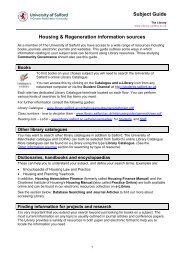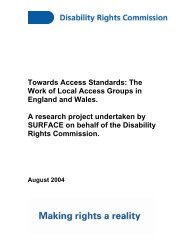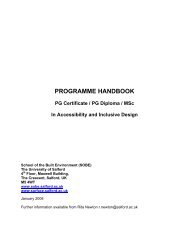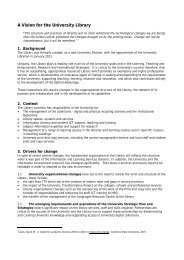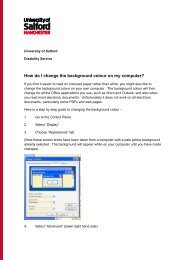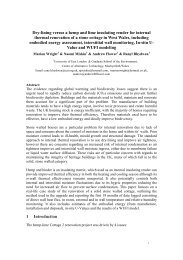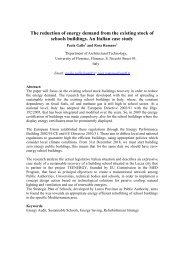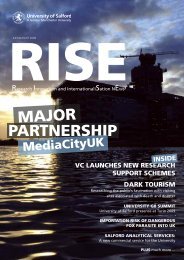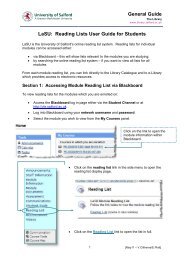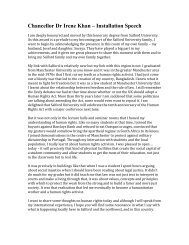Download a copy (pdf) - University of Salford
Download a copy (pdf) - University of Salford
Download a copy (pdf) - University of Salford
Create successful ePaper yourself
Turn your PDF publications into a flip-book with our unique Google optimized e-Paper software.
The mislabelling <strong>of</strong> fish is now amajor international concern.Fish stocks around the world arebeing over-exploited – in the last50 years nearly one in four <strong>of</strong> theworld’s fisheries has collapsed– and there has also been a dramatic rise inso-called IUU (illegal, unreported and unregulated)fishing. Worth as much as €20 billion a year, it’san industry that is putting further pressure on thesustainability <strong>of</strong> our fisheries in part due tomislabelling.Led by Dr Stefano Mariani, a marine biologist fromthe School <strong>of</strong> Environment & Life Sciences, a teamis investigating how to optimise and standardisethe way in which seafood products are geneticallyidentified, and ultimately make it easier toprosecute mislabelling <strong>of</strong>fenders. According toMariani, part <strong>of</strong> the problem stems from the factthat most fish are now processed at sea, wheremany <strong>of</strong> the features that set individual speciesapart are removed.As a result, fish is sold in such a processed statethat it’s hard to know exactly what type <strong>of</strong> fish itis. This can lead to product substitution, when lessvaluable, more common species are mislabelledas rarer and <strong>of</strong>ten more expensive fish. As well asbreaking quotas for certain species, and putting afurther strain on the sustainability <strong>of</strong> fish stocks,it’s a practice that also cheats the consumerand may also expose them to the risk <strong>of</strong> foodallergies. “But don’t blame the fisherman,” saysMariani. “It’s a complicated supply chain and it’sthe big processing plants, supermarket chainsand suppliers that will decide the fate <strong>of</strong> differentbatches and orders <strong>of</strong> fish.”A recent survey in Americashowed shocking levels<strong>of</strong> mislabelling, with over50% <strong>of</strong> fish wronglymarked.Worldwide issueIt’s a problem that is rife all over the world.A recent survey in America showed shocking levels<strong>of</strong> mislabelling, with over 50% <strong>of</strong> fish wronglymarked. And despite the strong regulationsintroduced by the EU, there’s evidence that tunaand swordfish caught in the Mediterranean, aswell as North Sea cod, are also being mislabelled.What Mariani believes is needed is a forensic testthat will enable investigators to check whetherfish have been caught illegally, or whether aproduct in a supermarket or restaurant has beenmislabelled. DNA testing is central to this, and<strong>of</strong>fers a quick, cost-effective and reliable method,which can distinguish between species andprovide the forensic evidence needed to take acase to court. However, at the moment, a variety<strong>of</strong> different methods are being used.Dr Stefano Mariani <strong>of</strong> theSchool <strong>of</strong> Environment &Life SciencesFish mislabellingA team <strong>of</strong> researchers at the <strong>University</strong> <strong>of</strong><strong>Salford</strong> is working on a process to stop aninsidious practice that is contributing to themismanagement <strong>of</strong> fish stocks worldwide.“The ultimate aim <strong>of</strong> the research is to producea simple, standardised process that allows you totake a piece <strong>of</strong> fish, subject it to the extraction<strong>of</strong> the DNA, and then the sequencing <strong>of</strong> aparticular portion <strong>of</strong> the DNA that identifiesthe actual species that you are dealing with,”explains Mariani. “It’s a process that is verysimilar to that which has been used in the recenthorse meat scandal.”Mariani’s research is part <strong>of</strong> a European projectcalled LABELFISH, which includes partners inIreland, Portugal, Spain, France and Germany, andwill focus on eight <strong>of</strong> the most popular species- Atlantic cod, haddock, hake, monkfish, plaice,tuna, ling and sardine. The research will also testthe effectiveness <strong>of</strong> EU legislation.Mariani’s team, and those in the partnercountries, have been testing shop-boughtsamples <strong>of</strong> fish using a variety <strong>of</strong> different DNAtesting technologies.“Traditionally different countries and differentgovernments had different control labs that wereusing different techniques to achieve the sameresults, and there was a lot <strong>of</strong> inconsistency.This can be a problem with potential legal cases.“We are aiming to standardise this wholeprocess as much as possible and hopefully this willthen become a model used around the world.“We want to ensure that in terms <strong>of</strong> procedure,collecting, delivery and reproducibility <strong>of</strong> all theresults, regardless <strong>of</strong> what country or laboratoryyou’re in, it’s going to be 100% reliable.“Ultimately,” he adds, “I would love to seenational, compulsory and well-enforced genetictesting, and random spot checking <strong>of</strong> productsalong the production chain in every country.”Below: Dr Mariani performs ademonstration at the ManchesterScience Festival in October 2012May 2013 | 39



